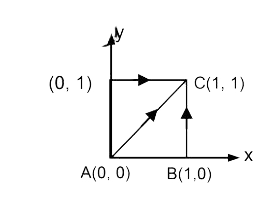The potential energy function associated with the force is
(a)
(b)
(c)
(d) Not defined
The correct Answer is:B
Also by reverse method using and
only option(b) satisfies the criteria.
Topper's Solved these Questions
- WORK, POWER & ENERGYBOOK - CENGAGE PHYSICSCHAPTER - WORK, POWER & ENERGYEXERCISE - Multiple Correct
25 Videos
- WORK, POWER & ENERGYBOOK - CENGAGE PHYSICSCHAPTER - WORK, POWER & ENERGYEXERCISE - Linked Comprehension
55 Videos
- WORK, POWER & ENERGYBOOK - CENGAGE PHYSICSCHAPTER - WORK, POWER & ENERGYEXERCISE - Subjective
23 Videos
- VECTORSBOOK - CENGAGE PHYSICSCHAPTER - VECTORSEXERCISE - Exercise Multiple Correct
5 Videos
Similar Questions
A single conservative force acting on a particle varies as →F=(−Ax+Bx2)ˆiN, where A and B are constants and x is in meters. (a) Calculate the potential energy function U(x) associated with this force, taking U=0 at x=0. (b) Find the change in potential energy and the change in kinetic energy of the system as the particles moves from x=2.00m to x=3.00m.
View SolutionThe potential energy associated with an electron in the orbit
View Solution
Knowledge Check
Assertion: Work done by friction over a closed path is not zero and no potential energy can be associated with friction.
Reason: Every force encountered in mechanics have an associated potential energy.AIf both assertion and reason are true and reason is the correct explanation of assertion.BIf both assertion and reason are true not but reason is not the correct explanation of assertion.CIf assertion is true but reason is falseDIf both assertion and reason are false.Assertion: Frictional forces are conservative forces.
Reason: Potential energy can be associated with frictional forces.AIf both assertion & Reason are True & the Reason is a corrrect explanation of the Asserion.BIf both Assertion & Reason are True but Reason is not correct explanation of the Assertion.CIf Assertion is Trie but the Reason is False.DIf both Assertion & Reason are falseA particle moves 5m in the +x direction while being acted upon by a constant force→F=(4N)ˆi+(2N)ˆj−(4N)ˆk . The work done on the particle by this force is
A20 JB10 JC−20JD30 J
A potential energy function for a two-dimensional force is the form U=3x2y−7x. Find the force that acts at the point (x,y).
View Solution[" 5.The potential energy function for a two dimensional force is "],[U=+2x^(3)-4x^(2)y+6y^(2)" where "U" is in joules,"x" and "y" are in metres.The force (in "N)],[" acting on particle at "(3m,2m)" is "(Ahat i+Bhat j)" newtons.Find "A+B?]
View SolutionCan you associate potential energy with a non conservative force ?
View SolutionA body constrained to move along y-axis is subjected to a constant force →F=−ˆi+2ˆj+3ˆkN. The work done by this force in moving the body a distance of 4 m along y-axis is
View SolutionA particle of mass m moves from A to C under the action of force →F=2xyˆi+y2ˆj , along different paths as shown in figure.

View Solution
